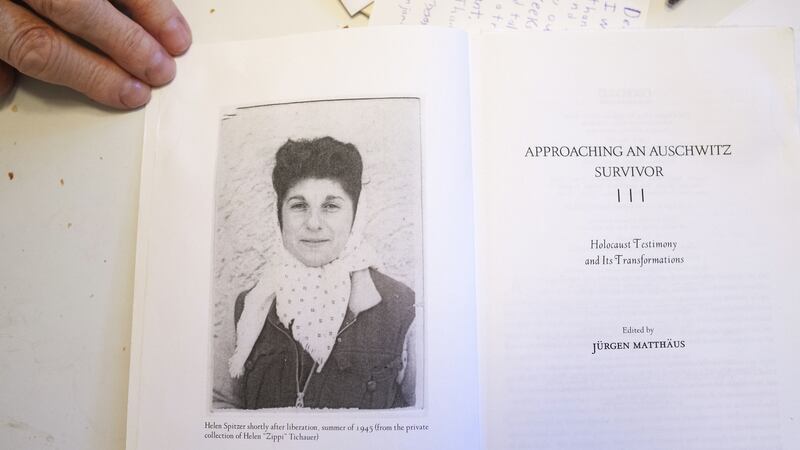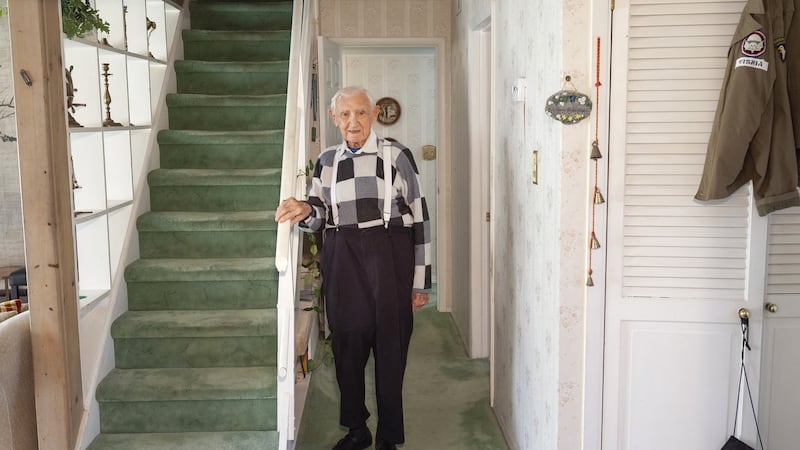The first time he spoke to her, in 1943, by the Auschwitz crematory, David Wisnia realised that Helen Spitzer was no regular inmate. Zippi, as she was known, was clean, always neat. She wore a jacket and smelled good. They were introduced by a fellow inmate, at her request.
Her presence was unusual in itself: a woman outside the women’s quarters, speaking with a male prisoner. Before Wisnia knew it, they were alone, all the prisoners around them gone. This wasn’t a coincidence, he later realised. They made a plan to meet again in a week.
On their set date, Wisnia went as planned to meet at the barracks between crematories four and five. He climbed on top of a makeshift ladder made up of packages of prisoners’ clothing. Spitzer had arranged it, a space amid hundreds of piles, just large enough to fit the two of them. Wisnia was 17 years old; she was 25.
“I had no knowledge of what, when, where,” Wisnia recently reminisced at age 93. “She taught me everything.”
They were both Jewish inmates in Auschwitz, both privileged prisoners. Wisnia, initially forced to collect the bodies of prisoners who committed suicide, had been chosen to entertain his Nazi captors when they discovered he was a talented singer.
Spitzer held the more high-powered position: She was the camp’s graphic designer. They became lovers, meeting in their nook at a prescribed time about once a month. After the initial fears of knowing they were putting their lives in danger, they began to look forward to their dates. Wisnia felt special. “She chose me,” he recalled.
They didn't talk much. When they did, they told each other brief snippets of their past. Wisnia had an opera-loving father, who'd inspired his singing, and who'd perished with the rest of his family at the Warsaw ghetto. Spitzer, who also loved music — she played the piano and the mandolin — taught Wisnia a Hungarian song. Below the boxes of clothing, fellow prisoners stood guard, prepared to warn them if an SS officer was approaching.
For a few months, they managed to be each other’s escape, but they knew these visits wouldn’t last. Around them, death was everywhere. Still, the lovers planned a life together, a future outside of Auschwitz. They knew they would be separated, but they had a plan, after the fighting was done, to reunite.
It took them 72 years.
*****
On a recent afternoon this fall, Wisnia sat in his house of 67 years in his adopted hometown in Levittown, Pennsylvania, looking through old photographs. Still a passionate singer, Wisnia spent decades as a cantor at the local congregation. Now, about once a month, he gives speeches where he tells war stories, usually to students and sometimes at libraries or congregations.
“There are few people left who know the details,” he says.
Spitzer was among the first Jewish women to arrive in Auschwitz in March of 1942. She came from Slovakia, where she attended a technical college and said she was the first woman in the region to finish an apprenticeship as a graphic artist. In Auschwitz, she arrived with 2,000 unmarried women.
At first, she was assigned gruelling demolition work at the sub-camp, Birkenau. She was malnourished and perpetually ill with typhus, malaria and diarrhea. She persisted as a labourer until a chimney collapsed on her, injuring her back. Through her connections, her ability to speak German, her graphic design skills and sheer luck, Spitzer secured an office job.

Her initial assignments included mixing red powder paint with varnish to draw a vertical stripe on female prisoners’ uniforms. Eventually, she started registering all female arrivals in camp, she said in 1946 testimony documented by psychologist David Boder, who recorded the first interviews with survivors after the war.
By the time Spitzer met Wisnia, she was working from a shared office. Together with another Jewish woman, she was responsible for organising Nazi paperwork. She made monthly charts of the camp’s labour force.
As Spitzer’s responsibilities grew, she was free to move around within parts of the camp and sometimes was allowed excursions outside. She showered regularly and didn’t have to wear an armband. She used her extensive knowledge of the grounds to build a 3D model of the camp. Spitzer’s privileges were such that she managed to correspond with her only surviving brother in Slovakia through coded postcards.
Yet Spitzer was never a Nazi collaborator or a kapo, a Jew assigned to oversee other prisoners. Instead, she used her position to help inmates and allies. She used her design skills to manipulate paperwork and reassign prisoners to different job assignments and barracks. She had access to official camp reports, which she shared with various resistance groups, according to Konrad Kwiet, a professor at the University of Sydney.
*****
Kwiet interviewed Spitzer for an essay published in the book Approaching an Auschwitz Survivor. In the book, edited by Jürgen Matthäus, director of applied research at the United States Holocaust Memorial Museum, Spitzer was interviewed by five different historians, each chronicling her life from a different perspective.
“It’s certainly not surprising to me that people in Zippi’s position would have lovers and they would try to use their influence to save people,” says Atina Grossmann, a professor at the Cooper Union in New York who interviewed Spitzer for the book.
“For everybody you saved, you were condemning someone else,” Grossmann says. “You had to be very precise, and that’s how you kept the Germans at bay.”
Wisnia was assigned to the “corpse unit” when he arrived. His job was to collect bodies of prisoners who’d flung themselves against the electric fence surrounding the camp. He dragged those corpses to a barrack, where they were hauled off by trucks.
Within months word got around that Wisnia was a gifted singer. He started singing regularly to Nazi guards and was assigned a new job at a building the SS called the Sauna. He disinfected the clothing of new arrivals with the same Zyklon B pellets used to murder prisoners in the gas chamber.
Spitzer, who had noticed Wisnia at the Sauna, began making special visits. Once they had established contact, she paid off inmates with food to keep watch for 30 minutes to an hour each time they met.
Their relationship lasted several months. One afternoon in 1944 they realised it would probably be their final climb up to their nook. The Nazis were transporting the last of the camp prisoners on death marches and destroying evidence of their crimes.
As crematories were demolished, there were whispers within the camp that the Soviets were advancing. The war might end soon. Wisnia and Spitzer had survived Auschwitz for more than two years while most prisoners never made it past a few months. In Auschwitz alone, 1.1 million people were murdered.
During their last rendezvous they made a plan. They would meet in Warsaw when the war was over, at a community centre. It was a promise.
*****
Wisnia left before Spitzer on one of the last transports out of Auschwitz. He was transferred to the Dachau concentration camp in December 1944. Soon after, during a death march from Dachau, he happened upon a hand shovel. He struck an SS guard and ran. The next day, while hiding in a barn, he heard what he thought were Soviet troops approaching. He ran to the tanks and hoped for the best. It turned out to be Americans.
He couldn’t believe his good fortune. Since he was 10 years old, Wisnia had dreamed of singing opera in New York. Before the war, he’d written a letter to president Franklin D Roosevelt requesting a visa so he could study music in America. His mother’s two sisters had emigrated to the Bronx in the 1930s, and he’d memorised their address. Throughout his ordeal in Auschwitz, that address had become a sort of prayer for him, a guidepost.
Now, faced with soldiers from the 101st Airborne, he was beyond relieved. The troops adopted him after hearing his tale, told in snippets of the little English he spoke, some German, Yiddish and Polish. They fed him Spam, he says, gave him a uniform, handed him a machine gun and taught him to use it. Europe would be his past, he decided. “I didn’t want anything to do with anything European,” he says. “I became 110 per cent American.”
Even though, as a Pole, he never could become a full-fledged GI, Wisnia performed numerous jobs after the war with the American army. He worked at the Army Post Exchange, which provided basic supplies to soldiers. He also sometimes drove to the displaced persons camp in the city of Feldafing to deliver supplies. Once he’d joined the Americans, his plan to meet Zippi in Warsaw was no longer even a consideration. America was his future.

Spitzer was among the last to leave the camp alive. She was sent to the women’s camp at Ravensbrück and a sub-camp in Malchow before being evacuated in a death march. She and a friend escaped the march by removing the red stripe she had painted on their uniforms, allowing them to blend with the local population that was fleeing.
As the Red Army advanced and the Nazis surrendered, Spitzer made her way to her childhood home in Bratislava, Slovakia. Her parents and siblings were gone, save for one brother, who’d just gotten married. She decided to leave him unburdened to start his new life.
*****
According to Grossmann, the historian, Spitzer’s account of her journey immediately after the war was deliberately vague. She alluded to smuggling Jews across borders through the Bricha, an underground movement that helped refugees move illegally across Eastern Europe and into Palestine.
Millions of survivors were displaced, and Europe was teeming with displaced persons camps. Some 500 such camps materialised in Germany. Amid the chaos, Spitzer made it to the first all-Jewish displaced persons camp in the American zone of occupied Germany, which in the spring of 1945 housed at least 4,000 survivors. It was called Feldafing, the same camp that Wisnia would deliver supplies to.
The odds they would be in the same place were remarkable. “I would drive over there to Feldafing, but I had no idea she was there,” Wisnia says.
Soon after she arrived in Feldafing in September of 1945, Spitzer married Erwin Tichauer, the camp’s acting police chief and a United Nations security officer, roles that allowed him to work closely with the American military. Once again, Spitzer, now known as Tichauer, was in a privileged position. Although they, too, were displaced persons, the Tichauers lived outside the camp.
Eventually, the Tichauers moved to America, first to Austin, Texas, and in 1967 they settled in New York, where Tichauer became a bioengineering professor at New York University. In their apartment, surrounded by books about the Holocaust, Tichauer spoke regularly with historians. She never gave speeches and said she despised the concept of the Holocaust as a business. The historians she entrusted with her story became part of her family. Kwiet, who called her from Australia every Friday, saw Tichauer as a mother figure.
“Her duty was not to be a professional survivor,” says Grossmann. “Her job was to be the historian’s historian. She was committed to this very sober, almost technical rendition of what happened.”
Yet throughout the many hours she devoted to detailing the horrors of Auschwitz to a number of historians, Tichauer never once mentioned Wisnia.
Sometime after the war ended, Wisnia heard from a former Auschwitz inmate that Tichauer was alive. By then he was deeply enmeshed with the American army, based in Versailles, where he waited until he could finally emigrate to the United States.
Over the years, Wisnia kept tabs on Tichauer through their mutual friend. Meanwhile, his family grew — he had four children and six grandchildren. In 2016 Wisnia decided to try again to reach out to Zippi. He’d shared the story with his family. His son, who was now a rabbi at Reform synagogue in Princeton, New Jersey, initiated contact for him. Finally, she agreed to a visit.
*****
In August 2016, Wisnia took two of his grandchildren with him to the reunion with Tichauer. He was silent during most of the car ride from Levittown to Manhattan. He didn’t know what to expect. It had been 72 years since he’d last seen his former girlfriend. He’d heard she was in poor health but knew very little about her life. He suspected she’d helped to keep him alive and wanted to know if this was true.
When Wisnia and his grandchildren arrived at her apartment in the East 30s, they saw Tichauer lying in a hospital bed, surrounded by shelves filled with books. She had been alone since her husband died in 1996, and they never had any children. Over the years, bed-bound, she’d gone increasingly blind and deaf. She had an aide looking after her, and the telephone had become her lifeline to the world.
At first, she didn’t recognise him. Then Wisnia leaned in close.
“Her eyes went wide, almost like life came back to her,” says Wisnia’s grandson Avi Wisnia (37). “It took us all aback.”
Suddenly there was a flow of words between Wisnia and Tichauer, all in their adopted English tongue.
“She said to me in front of my grandchildren, she said, ‘Did you tell your wife what we did?’” Wisnia remembered, chuckling, shaking his head. “I said, ‘Zippi!’”
Wisnia talked about his children, his time in the American army. Tichauer spoke about her humanitarian work after the war and her husband. She marvelled at Wisnia’s perfect English. “My God,” she said. “I never thought that we would see each other again — and in New York.”
The reunion lasted about two hours. He finally had to ask: Did she have something to do with the fact that he’d managed to survive in Auschwitz all that time?
She held up her hand to display five fingers. Her voice was loud, her Slovakian accent deep. “I saved you five times from bad shipment,” she said.
“I knew she would do that,” Wisnia said to his grandchildren. “It’s absolutely amazing. Amazing.”
There was more. “I was waiting for you,” Tichauer said. Wisnia was taken aback. After she escaped the death march, she had waited for him in Warsaw. She’d followed the plan. But he never came.
She had loved him, she told him quietly. He had loved her, too, he said.
Wisnia and Tichauer never saw each other again. She died last year at age 100. On their last afternoon together, before Wisnia left her apartment, she asked him to sing to her. He took her hand and sang her the Hungarian song she taught him in Auschwitz. He wanted to show her that he remembered the words. – New York Times





















